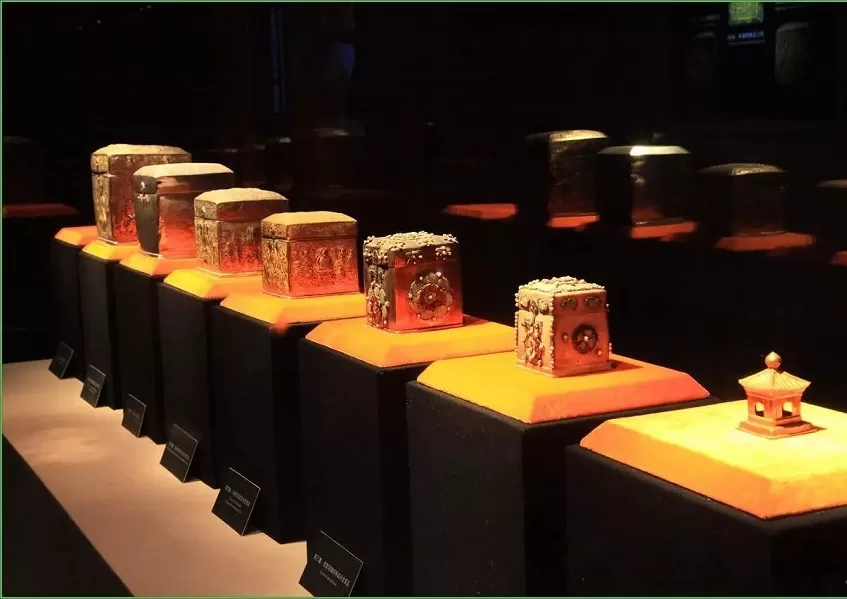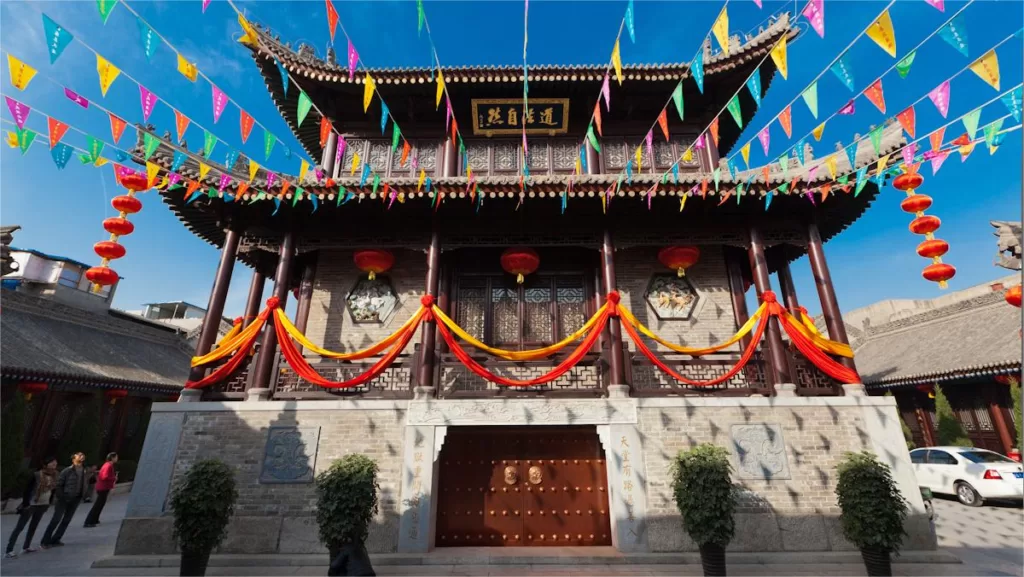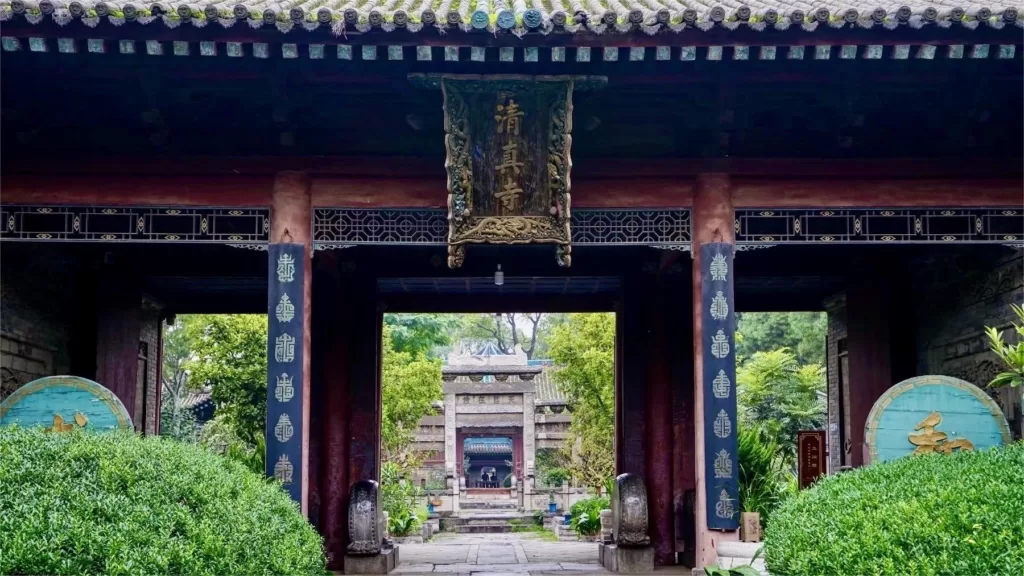Famen Temple (法门寺), also known as the “True Body Pagoda,” is a Buddhist temple with a rich history that dates back to the late Eastern Han Dynasty during the reign of Emperor Huan of Liu Song. With a history spanning over 1700 years, it holds the honorary title of “the ancestor of pagodas in Guanzhong.” It was previously known as the “Ashoka Temple” in the Zhou and Wei periods, later renamed “Chengshi Daochang” during the Sui Dynasty and ultimately “Famen Temple” during the reign of Emperor Gaozu of the Tang Dynasty. Famen Temple is revered as a royal temple, primarily due to its enshrinement of the relic of Shakyamuni Buddha’s finger bone, making it a revered Buddhist pilgrimage site for the entire nation.
Famen Temple’s underground palace is the largest pagoda underground palace known to date. It has yielded invaluable treasures of Buddhism, including the finger bone relic of Shakyamuni Buddha, a bronze stupa, an eight-layered treasure chest, a silver lotus with double wheels, and a twelve-ringed silver staff. The Famen Temple Treasure Hall houses over two thousand artifacts unearthed from the site, making it a treasury of cultural and historical significance, unparalleled among temples worldwide.
Table of Contents
- Basic Information
- Transportation and Location
- History of Famen Temple
- Highlights of Famen Temple
- Vlog about Famen Temple
- Useful Tips Summarized from Reviews
- Other Temples in Shaanxi
Basic Information
| Website | http://www.famensi.com/ |
| Estimated Length of Tour | About 2 hours |
| Ticket Price | 100 RMB (1st March – 30th November) 90 RMB (1st December – 28th February the next year) Children between 1.2 and 1.4 meters enjoy a half-price discount Children under 1.2 meters or 6 years old and seniors over 65 years old are free of charge |
| Opening Hours | 8.30 – 19.00; Last admission: 18.30 (1st March – 30th November) 9.00 – 18.00; Last admission: 17.30 (1st December – 28th February) |
| Telephone Number | 0086-0917-5258888 0086-0917-5258890 |
Transportation and Location
The Famen Temple is located in Famen town, Fufeng County, Baoji City, in the northwest of Shaanxi Province, China. It is about 110 kilometers west of Xi’an, the provincial capital of Shaanxi. But there are still several ways to travel there.
Take tourist line 2 at the East Square of Xi’an Railway Sation, which will take you directly to the Famen Temple. It departs at 8 am and returns at 3 pm. The fare is 25 RMB one-way.
Take the bus at Tang Paradise to reach the temple. The ride is free if you have purchased the ticket to Famen Temple. It departs at 9 am and returns at 4.30 pm.
Take a coach at the Xi’an West Terminal (西安城西客运站) to Fufeng Town and transfer to a local bus there. The coach departs every half an hour.
History of Famen Temple
According to historical records, the Famen Temple was built during the Eastern Han dynasty (25-220 AD), although it was known by a different name at the time. The temple was originally a small shrine that housed a piece of bone believed to be from the Buddha’s body. This relic had been passed down through the royal family of the Han dynasty and was highly revered by the people of the time.
During the Tang dynasty (618-907 AD), the Famen Temple became a major Buddhist center in China, and the relic housed within the temple was considered one of the most important in the country. It was said to have been brought to China by the famous monk Xuanzang, who had traveled to India to study Buddhism and had returned with many valuable scriptures and artifacts.
In the years that followed, the Famen Temple underwent many changes, both in its physical structure and in its significance as a cultural and religious site. It was destroyed and rebuilt several times, and many of its treasures were lost or stolen.
However, in 1981, a major archaeological discovery was made at the Famen Temple when a hidden underground chamber was found beneath the temple’s pagoda. This chamber contained a large number of valuable artifacts and treasures, including gold and silver statues, porcelain figurines, jade jewelry, and most importantly, a finger bone believed to be from the Buddha Sakyamuni.
This discovery sparked a renewed interest in the Famen Temple, and efforts were made to restore the temple and its artifacts to their former glory. Today, the Famen Temple is a popular tourist destination in China, and it is visited by thousands of people each year who come to see its beautiful architecture, ancient relics, and religious significance.
Highlights of Famen Temple
The Famen Temple Pagoda

Famen Temple Pagoda, also known as the True Body Pagoda, derives its name from the fact that it enshrines the true body relic of the Buddha. Originally referred to as the “Holy Mound,” it was during the Tang Dynasty that a four-story wooden pagoda was constructed. Subsequently, during the Ming Dynasty, it was reconstructed as a brick pagoda. However, on August 24, 1981, half of the pagoda collapsed, leaving only a portion standing. In the spring of 1987, the Tang Dynasty’s pagoda base was unearthed, confirming that it had a square shape with sides measuring 26 meters. The structure was wooden, supported by four load-bearing columns and twenty surrounding columns, creating a pavilion-like design. In 1988, a restoration project using a steel-reinforced concrete framework and blue bricks replicated the pagoda’s original appearance. The pagoda now stands at thirteen stories high and reaches an impressive height of forty-seven meters. An observation platform was constructed inside the pagoda, allowing visitors to ascend and enjoy breathtaking views of the surroundings.
The Famen Underground Palace

The discovery of the Tang Dynasty underground palace at Famen Temple in 1987 marked the most ancient, grand, and highest-ranked Buddhist pagoda underground palace in the world. The vast collection of artifacts stored in the underground palace is of exceptional quality, with some items appearing nearly pristine. These artifacts provide tangible evidence for the study of various disciplines, including Tang Dynasty politics, economics, culture, and religion. They hold significant importance for both Chinese cultural history and world cultural history. The cultural relics from Famen Temple’s underground palace represent the pinnacle of Tang Dynasty culture.
The Famen Temple Treasure Hall

The Famen Temple Museum, also known as the Famen Temple Treasure Hall, features exhibition halls located on the second and third levels of the Treasure Pavilion. The exhibition includes a “Famen Temple Excavated Artifacts Exhibition,” displaying over 160 high-quality artifacts, all of which were unearthed from the underground palace. These relics represent the essence of the Tang Dynasty’s imperial cultural heritage, making this exhibition a unique cluster of historical and cultural treasures. Additionally, within the underground palace, there is a “Underground Palace Treasures Exhibition” that allows visitors to delve deeper into the splendor of this remarkable Buddhist sanctuary.
The Famen Temple Reliquary

The precious Reliquary consists of eight layers that vary in size and are nested within each other. Each layer is dazzlingly brilliant, and as they are opened in succession, they reveal their splendor. The outermost layer is the eighth layer, which is a sandalwood casket with silver edges. It appears externally as a refined black lacquered box that is 30 centimeters in length, width, and height. The box is adorned with carved silver edges and is entirely made of precious sandalwood. The interior walls are painted with glossy black lacquer. This sandalwood casket was discovered in a severely decayed state.

The seventh layer is a silver casket crowned by four gold-plated heavenly guardians. The sixth layer is a plain silver casket. The fifth layer is a silver casket with a gold-plated top that features the Buddha’s teachings. The fourth layer is a pure gold casket with a six-armed Avalokitesvara at the top. The third layer is a pure gold casket decorated with a golden basket, jeweled ornaments, and pearls. The second layer is a black stone casket decorated with a golden basket, jeweled ornaments, and pearls. Finally, when the innermost layer is opened, the first layer is revealed – a pure gold tower with a single eave and four doors, topped with a precious jewel. The tower’s flying eaves are raised high, and a small silver column, only 11 centimeters tall, stands atop the golden tower’s base.
Vlog about Famen Temple
Useful Tips Summarized from Reviews
Choosing the Entrance: If you enter from the old entrance (South Second Gate), you can directly visit the Treasure Hall and the Old Pagoda Tower. Afterward, it only takes a few minutes to reach the newly constructed Ten Merits Stupa to pay respects to the true relics of the Buddha. However, if you enter from the new entrance, it’s about a 2-kilometer walk to reach the Ten Merits Stupa, which can be quite hot and sunny. Alternatively, you can take an electric car for 30 yuan per person. Along the way, you’ll be treated to magnificent views, with many gigantic Buddha statues adorning both sides of the route.
Be Mindful of the Museum: The Famen Temple Museum mostly houses replicas. Visitors, especially those on guided tours, should be cautious when visiting the area known as the Cultural and Creative Museum, as it often encourages purchases, and the prices tend to be high.
Viewing the True Body Relics: The true body relics are only exhibited on the first and fifteenth day of the lunar month. They are not open to the public on Saturdays, Sundays, or during regular weekdays.
Vegetarian Meals Available: Outside the Buddha Light Avenue, there are vegetarian meals available for 28 yuan per person, offering a convenient dining option for visitors.
Watch Out for Sellers: There are many sellers offering incense in the parking lot and within the scenic area. Additionally, there are guides or promoters inside the scenic area. Exercise caution and discernment to distinguish between official guides and others.




